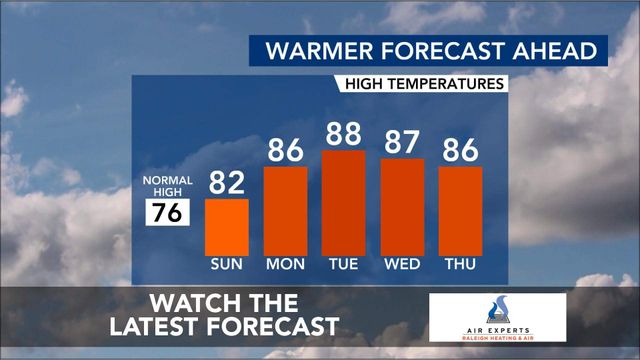Brrr - Right on Time?

You've probably heard us talking for a few days now about some "unseasonably cold" air making its way into central North Carolina to give us some chilly temperatures for a few days, including highs that run in the low to mid 50s and what will likely turn out to be our first fairly widespread freezing temperatures of the fall season.
This actually creates a seemingly odd juxtaposition of statistically based references in our forecast, because while it is quite reasonable to call today's forecast high of 53 "unseasonably cool," given that the "normal" high for the date is 68 degrees and the standard deviation of the high for this time of year is +/- 8 degrees. That means that historically, a high that cool for this date only has about a 3-4% chance of occurring, being almost two standard deviations shy of normal.
At the same time, if we indeed manage to fall to 32 degrees or below at the airport in the next day or two, it will be very nearly "normal" for our first freeze of the season there. The average first freeze date for RDU is October 28th, and while it looks like we'll slip past today with a close call (low of 34 so far today as I write this) we have a pretty good chance of making that mark within one or two days of the average this year, while historically the standard deviation for the first freeze is +/- 9 days, meaning that we have our first freeze somewhere between the 19th of October and the 6th of November about two thirds of the time - add 9 more days to either end of that range and you should cover about 95% of our first freeze dates.
So if it pretty typical for us to hit 32 or less for the first time near today's date, why would chilly air be deemed "unseasonable?" The difference is in the importance we attach to the normal first occurrence of freezing temperatures as opposed to the first date at which it is "normal" to have freezing temperatures. It's a subtle distinction, but we don't have 32 or below as an average low temperature until December 16th. So, even though it may be considered normal to have that first freeze this early, the 32 degree low itself is well below normal on this date (with the normal low about 44 degrees) just like the "unseasonably cool" high of 53.
Finally, you might be wondering about a "first frost" date. Because frost can occur when air temperatures (measured about 4-5 feet above the ground) are several degrees above freezing, and very localized wind, sky exposure and terrain conditions can greatly affect whether frost occurs, we don't have really clear statistics about the first occurrence of frost at a given station. However, we can take a stab at an approximate "normal" for first frost by noting that it becomes fairly common for frost to be at least possible when air temperatures dip as low as 35-36 degrees. By checking the history of when these temperatures occur, we find that for RDU a rough "normal" for first frost would be about October 21st, or roughly a week before the first freeze. That worked out pretty close this year as well, as you may recall that numerous frost reports were noted around the area on the morning of October 20th, when RDU recorded a low of 35 degrees.
If you'd like to look up these first freeze and first frost statistics for many locations around the southeast, they are available at the Southeast Regional Climate Center (SERCC) web site, in both graphical and tabular form. The address is
http://www.sercc.com/climateinfo/historical/historical_nc.html
Just click the station you want to view, then look down the left side for the "Fall Freeze Probabilities" link. You'll get a graph that looks the one I attached, and there will be a "tabular" link below the graph that will give you a different look at the same data.









